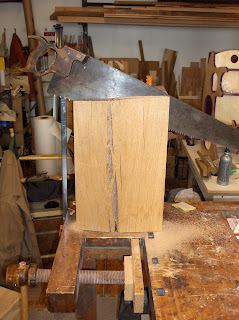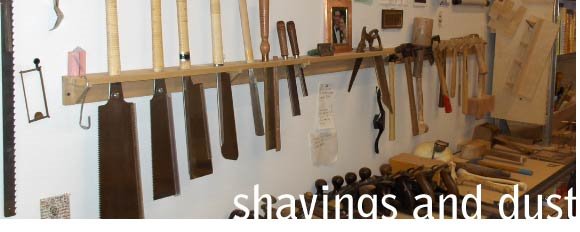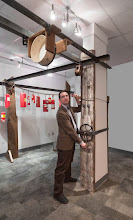I have written before about South County Post and Beam, which is a post and beam building company here in the Isle of Rhodes. They are very nice, and they give me their off-cuts when they make beams. So I have kicking around the studio a couple of very big chunks of wood. Which I of course love. This particular piece is about 18” tall, and about 8” by 12”. Solid piece of wood. Weighs about thirty pounds. I have had it for a while, waiting for it to tell me what it wants to be, and now it has.
When a tree is cut down, is immediately begins to divest itself of water. The trunk of a tree, after all, exists pretty much exclusively to move water from the roots up to the leaves, and then move nutrients back down to the tree. That is what the trunk (where wood comes from) is for. I could do a whole post just about the beauty and sublime functionality of trees, but that will wait for another time. The point is, as they divest themselves of water, and as they do so, they shrink. And they change shape. So what had been a square beam now was warped and twisted, and I wanted to square it up. One edge and one face could be taken to the jointer, a big machine that does this kind of thing, but our planer will only accept 6” thick lumber. Somehow I had to cut two inches off the side of this thing in order to get it through the planer.
First I tried our big old 1912 Tannewitz band saw. Good saw, but the blade needs replacing, and that much oak was too much for it. Blue smoke started to pour out from the bottom of the work piece. Smoke, generally, is not good. Oak 1, power tools 0.
Next I took it to the table saw. The blade will only project about 3” from the table of the saw, so that was clearly not the answer, either. Oak 2, power tools 0. I knew what I had to do, of course.
I have been re-reading one of my sacred texts, “The Village Carpenter” by Walter Rose. Rose’s family had owned and operated a sawyery and woodworking shop for generations when he wrote about it in 1937. He writes incredibly eloquently about two large men using a saw between them to reduce logs to planks. Hard, sweaty, slow work. Slow but effective. The thing is, humans are not more powerful than power tools, but they are able to vary the speed and power that they have to accommodate the work piece in a way that a machine can not. That kind of approach was what was needed with this great big chunk of red oak.
On the wall of my studio hangs a rip saw (“ripping” is cutting with the grain of the wood. I also have “cross-cut” saws, which are for cutting across the grain of the wood). Well, more than one, actually, but there is one in particular that is special to me, as it is a family tool. As near as anyone can tell, it belonged to Gardner Greene, who was my great- great-grandfather. I was made in the late 19th century. Nothing special, really, not a collector piece by any means. Just a good, sturdy handsaw. Somehow it has survived the hundred-plus years and come to me in good shape, and intact.

There is a gentleman down in Cranston that is a saw sharpener. Used to be pretty easy to find a good saw sharpener. Harder, now, as saws, like so many things, are made to be used and then discarded. He is the only person in this state that I have found that does handsaws anymore. There might be others, but he is the person that I entrust my saws to. Took him old Gardner’s saw and he did a great job of setting the teeth and jointing them flat and sharpening them up until they were as good as they were the day the saw was sold. Rose writes about a saw “humming” through the wood, singing a song as it works. That is how this saw works. So I clamped the great big chunk of lumber to the bench and set to work. I happened to note the time, it was about 2.10 pm. At about 2.15, I thought I would take a photo of my progress.
Back and f
 orth, back and forth. The saw made a tidy pile of sawdust on the far side of the workpiece. The tannin-y scent of red oak wafted out from inside the block, the smell of wood that has not ever been exposed to air. I have written before about how every wood has its own smell as you work it, and red oak (a studio mate of mine calls it “piss oak,” because the tannin smell can be very sharp and almost overpowering sometimes) always makes me think of red wine, that sharp taste that tannins in the oak aging barrels give it when you drink it. Here is where I was at 2.25pm.
orth, back and forth. The saw made a tidy pile of sawdust on the far side of the workpiece. The tannin-y scent of red oak wafted out from inside the block, the smell of wood that has not ever been exposed to air. I have written before about how every wood has its own smell as you work it, and red oak (a studio mate of mine calls it “piss oak,” because the tannin smell can be very sharp and almost overpowering sometimes) always makes me think of red wine, that sharp taste that tannins in the oak aging barrels give it when you drink it. Here is where I was at 2.25pm.
Sawing and sawing. It is not about speed, this kind of work. It is about care, and about making sure that every time the saw moves forward, it is following the scribed line. It is about endurance. The wood has a lot of twist in it, and it started to grab the saw blade a little, so I rubbed paraffin on it and drove a couple of screwdrivers into the top of the block to take tension off of the blade. You can see them in this photo. At 2.35 I was here:

And here is a photo of me sawing. Well, actually, I had paused for the photo. I wanted to preserve it because of the resonance of this particular project. So it is staged, but truth to tell I was tired and wanted a break.

Finally, finally, the off-cut fell away, I was able to run the block through the planer, and get it very smooth and very square. It will likely not stay that way, but so it is for now. Here it is at 2.45pm, roughly a half hour of near continuous work after I started. Boy, were my arms tired. I was winded. And I had only cut through a foot and a half. Imagine using this method to reduce a whole tree to planks.
And here is a
 shot of the top of the block, showing the beautiful growth rings. Each ring, of course, happened over a year. I can count 70 years, from the pith (that is the center of all the rings, and is actually the sapling that this tree started from) to the far corner. And, of course, the tree was older yet than that, when it was felled. It was a baby before World War I. Maybe even before the dawn of the last century. It was a callow youth when Gardner Greene bought the handsaw I used on it today. It grew slowly and patiently through wars and unrest, through financial boom and bust. What is money to an oak tree? It grew as my grandparents were born, and as my parents were born. It was a good, sturdy tree when the first human footprint was made on the moon. It was older than I will be when I pass when I was born.
shot of the top of the block, showing the beautiful growth rings. Each ring, of course, happened over a year. I can count 70 years, from the pith (that is the center of all the rings, and is actually the sapling that this tree started from) to the far corner. And, of course, the tree was older yet than that, when it was felled. It was a baby before World War I. Maybe even before the dawn of the last century. It was a callow youth when Gardner Greene bought the handsaw I used on it today. It grew slowly and patiently through wars and unrest, through financial boom and bust. What is money to an oak tree? It grew as my grandparents were born, and as my parents were born. It was a good, sturdy tree when the first human footprint was made on the moon. It was older than I will be when I pass when I was born.Now it will be part of a piece of furniture that my sister’s family will hand down to their children and their grandchildren. It will be with them through the many good times and the occasional bad. It can be handed down and used and loved for many years, and I hope that when Ellie and Kelsey and Karen and I are just faces in a yellowed photograph that that table will still be in some descendant’s home, and that Gardner’s saw will be hanging on some unknown wall, sharpened and ready for use when available modern technology is not able to rise to the challenge.
Whoever uses the saw then will be sawing with me today, just as today I was sawing with my father in the forties when he was young, and just as I was sawing with Gardner when he was doing the same thing. We are linked through time by family, by tradition, by labor, and by our impulse as makers. I am incredibly proud to stand in that line.


3 comments:
I am so very glad that our descendants will share a common history.
Beautifully written.
I love the little puff of sawdust that comes out each time you saw... a lot of things kind of feel like that- slow change.
I love your description of wood (and your sushi entry too) it just makes it come alive and shows a great respect to the material as well.
Steven
Post a Comment